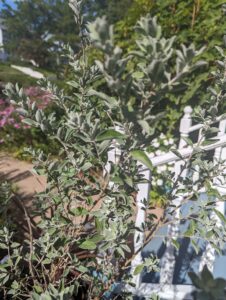 I have fallen in love with a tall Texan, and, if that isn’t enough to scare the relatives, my Texan is very prone to falling over. At the moment it is very hard to keep this handsome individual grounded, though he hardly drinks at all. I have sworn to find a way.
I have fallen in love with a tall Texan, and, if that isn’t enough to scare the relatives, my Texan is very prone to falling over. At the moment it is very hard to keep this handsome individual grounded, though he hardly drinks at all. I have sworn to find a way.
The name of my latest botanical inamorato? Leucophyllum frutescens, better known to its friends as Texas sage or “Texas barometer bush”. “Leucophyllum” means “white leaves”, which is almost true; the soft, hairy leaves are silvery green, as befits a plant that has evolved to reflect the harsh sunlight of its native region. “Frutescens” means “shrublike”, which is the natural form of a woody plant that grows up to eight feet tall and six feet wide. My Texas sage is in a large-ish container and, when I bought it, had already been trained in standard or tree form, so it is about five feet tall, with a two-foot wide crown. That is why it is prone to falling over on windy days. I will either have to transplant it to a larger container with a brick at the bottom, or find an outdoor spot for this handsome plant where I can affix it to a support by means of a stout bungee cord.
But enough about the weakness of my tall Texan. Native to the Chihuahuan Desert in northern Mexico, Texas and New Mexico, it is tough beyond measure. Its native environment boasts thin, calcareous soil and lots of dry heat. Thriving on drought, Texas sage, like many desert plants, blooms abundantly after sinking barometric pressure produces summer rainstorms, hence the “barometer plant” nickname.
My new plant was in bloom when I first saw it, flanking the entrance to an innovative nursery near my daughter’s apartment complex. She noticed it right away, but having only a small balcony that is already full of plants, she could only enthuse over its beauty. The best she could do was to bring the lanky Texas barometer to my attention in the hopes that I would be attracted to the silvery leaves and lovely pinkish purple flowers. Those blooms are small, only about an inch long, but they sprout in quantity from the leaf axils or spaces where leaves and stems meet. The leaves are about the same length and narrow, so the total effect is bright but refined.
Predictably, I was strongly attracted to the little tree, but there was a slight hitch—the plant tag was silent on zone hardiness. Since I already have a fair-sized oleander and an equally large clerodendron that must be hauled in for the winter, I was cautious. The Texas name did not help.
A salesperson told us that Texas sage is indeed frost-tender and would have to spend northeastern winters indoors in a sunny spot. I decided to deliberate for a few minutes and strolled around the plant pallets, selecting a lovely, winter-hardy variegated sedum to take home. I searched among the sale racks for bargains and ambled through the other shrubs in search of something beautiful that was better suited to my cold-winter climate.
I found myself returning to the Texas sage several times and decided that it might not be as heavy as I originally thought. My credit card leaped out of my wallet like magic and the tree-form sage just fit in the back of my car. I took that as a good sign.
Of course, the new plant is not a true sage, but a member of the unfortunately named Scrophulariaceae or figwort family, home to familiar garden favorites like snapdragon. The family is distinguished, but not being a true sage means that the leaves of my Texas sage do not have the aromatic sage smell.
It doesn’t matter. I have other sages, but I have never had a Leucophyllum frutescens. Now that I do, I am relieved that it doesn’t require much tending, other than ensuring that it stands upright, and pruning wayward stems to keep it in standard form. The plant needs minimal water and does not appreciate the fertilizer doses required to keep other species in peak condition.
And I will haul it in when night temperatures start to fall into the lower fifties. At least there is no wind in the house.
In warm winter climates, shrub-form Texas sage can be used as a specimen shrub or as a flowering hedge. Those of us with cold winters have to content ourselves with standards, or shrubs in large containers that can be moved into houses, greenhouses or other climate-controlled spaces. If you are undeterred by that, try ordering one from Eureka Farms, 16700 SW 184th St Miami, Florida 33187; (305) 234-9588; http:// www.eureka-farms.com.
